Papers by Constancio Asis
Abstracts of the Annual Meetings, Japanese Society of Soil Science and Plant Nutrition, 2000
Abstracts of the Annual Meetings, Japanese Society of Soil Science and Plant Nutrition, 2003

Short NoteAnalysis of the from soybeanBradyrhizobium nod gene-inducers super!hypernodulating muta... more Short NoteAnalysis of the from soybeanBradyrhizobium nod gene-inducers super!hypernodulating mutants' Constancio A. Asis, Jr.'), Masatsugu Kubotai), Kiwamu Minamisawa2) and Shoichiro Akao3)*' i' School of Agrict{lluie, .lbamki (Jniversib', Ami, Ihanzki, 300-os93 laPan Z) bisti;tute o.f Genetic Ecologe,, 7bhoku L'iniveTsit}', Ktitahim. Aoba-kbl, Sendkei, 980-os12 .laPan 3' A・'ational institute of Agrobiog(rgical Resottrces, Ifrznnondoi, 7'Suhuba, foarafei, 305-0856 1dePan In the soybean-Bvac(v,,rhizobium symbiosis, the initial stage of nodule forniation is triggered by the release of the bacterial nod gene-inducing isoflavonoids from soybean plant. Analysis of the isoflavonoid contents in the seeds and roet extracts of 12-day-old uninoculated soybean cultivars and their super/hypernodulating mutant using HPLC revealed that isofiavonoids daidzein, genistein, and coumestrol were present in the roots but only daidzein and genistein could be detected in the seeds. Moreover, all the super/ hypernodulating soybean mutants showed lower isoflavonoid contents in the seecls and roots than their parent cultivars. These results suggest that in all the parent cultivars the genes which are probab]y responsible for controlling the isoflavonoid production are both affected during mutation despite the differences in the mutagen used and background of the seed materials.
Horticulture, Environment, and Biotechnology, 2021
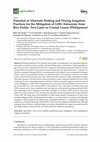
Agriculture, 2020
Reducing methane (CH4) emission from paddy rice production is an important target for many Asian ... more Reducing methane (CH4) emission from paddy rice production is an important target for many Asian countries in order to comply with their climate policy commitments. National greenhouse gas (GHG) inventory approaches like the Tier-2 approach of the Intergovernmental Panel on Climate Change (IPCC) are useful to assess country-scale emissions from the agricultural sector. In paddy rice, alternate wetting and drying (AWD) is a promising and well-studied water management technique which, as shown in experimental studies, can effectively reduce CH4 emissions. However, so far little is known about GHG emission rates under AWD when the technique is fully controlled by farmers. This study assesses CH4 and nitrous oxide (N2O) fluxes under continuous flooded (CF) and AWD treatments for seven subsequent seasons on farmers’ fields in a pumped irrigation system in Central Luzon, Philippines. Under AWD management, CH4 emissions were substantially reduced (73% in dry season (DS), 21% in wet season ...

Journal of environmental management, 2016
This study assessed the environmental consequences of burning and other rice straw management pra... more This study assessed the environmental consequences of burning and other rice straw management practices in terms of non-CO2 greenhouse gas (GHG) emissions, and evaluated the cost-effectiveness of selected rice straw management alternatives. On a per-hectare basis and considering a time horizon of five years, incorporating stubble more than 30 days before crop establishment, and incorporating composted rice straw in the field yielded the lowest cumulative CH4 and N2O emissions. Considering the associated costs and secondary benefits, the most cost-effective option for farmers is to incorporate stubble and straw in the soil more than 30 days before crop establishment. Rapid straw composting and incorporation of rice straw compost entails much higher additional cost but it also significantly mitigates GHG emission, hence it is the next most cost-effective option. Incorporating rice stubble and straw less than a month before crop establishment and removing rice straw for use as animal f...

Microbes and Environments, 2003
We collected stem samples from sugarcane germplasm of wildtype (43 clones of Saccharum spontaneum... more We collected stem samples from sugarcane germplasm of wildtype (43 clones of Saccharum spontaneum and S. robustum), cultivated (34 clones of S. hybrid spp., S. sinense, and S. barberi), and related grass species (7 clones of Erianthus arundinaceus, Miscanthus floridulus, and Ripidium sp.) to survey the colonization and population of diazotrophic endophytes in apoplast solution. Using the acetylene reduction assay-most probable number (ARA-MPN) method, 11 clones of wildtype species, nine clones of cultivated species, and three clones of related grass species were colonized by diazotrophic endophytes. The population density of diazotrophic endophytes in all ARA-positive samples ranged from 10 2 to 10 8 cells mL-1 apoplast solution and differed among clones and species. The results indicate a differential colonization and population of diazotrophic endophytes in stem apoplast solution.

Studies were conducted to determine the population of N2-fixing endophytes in the sugarcane stem,... more Studies were conducted to determine the population of N2-fixing endophytes in the sugarcane stem, analyze the carbon compounds (organic acid and sugar) in the stem apoplast solution, and estimate the contribution of N2-fixation to the nitrogen uptake of sugarcane (%Ndfa). The data gathered showed that the number of endophytic bacteria in the stem of sugarcane cultivars ranged from 104 to 109 cells / mL juice and varied among sites and cultivars. Moreover, not all of the stem apoplast solutions of sugarcane species and clones were colonized by N2-fixing endophytes. Among the acetylene reduction activity (ARA)+ samples, the number of N2-fixing endophytes was high in Saccharum robustum clone Robustum 16, S. sinense clone Kouchi, and S. hybrid cv. NCo310. The %Ndfa in sugarcane cv. NiF-8 ranged from 14.1 to 26.0% based on 15N dilution technique and 26.15 to 37.5% using the 615N abundance method. The identified organic acid compounds in stem apoplast solutions were aconitate, malate, and...
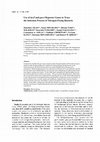
To determine whether the gusA gene, which encodes-glucuronidase (GUS) and lacZ gene, which encode... more To determine whether the gusA gene, which encodes-glucuronidase (GUS) and lacZ gene, which encodes-galactosidase are suitable for tracing nitrogen-fixing bacteria in the infection process, Bradyrhizobium japonicum strains labelled with each gene were constructed. Both introduced genes were expressed in rhizobia, but it was difficult to specify the sites where lacZ-labelled bacteria were present, since endogenous-galactosidase levels were high in soybean root tissues. On the other hand, endogenous-glucuronidase activity has not been detected in soybean root tissues. The gusA-marked Bradyhizobium, Rhizobium and Azospirillum strains were constructed for assessing the use of their GUS-marked bacteria to trace the presence of introduced bacteria manifested by colonization on the root surface, as well as infection sites, invasion modes and nodulation competitiveness between bacteria. Bradyrhizobium japonicum inoculated to soybean colonized in the form of spots on the root surface. In the spots, curling roots with infection threads were observed. In this report, we describe only the gusA-marked (Brady)rhizobium and Azospirillum strains which we constructed.
Advances in Biology and Ecology of Nitrogen Fixation, 2014
Plant Production Science, 1999
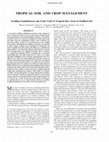
Agronomy Journal, 2000
nated seeds on the soil surface. The seeds are often eaten by birds and rats, desiccated in dry p... more nated seeds on the soil surface. The seeds are often eaten by birds and rats, desiccated in dry parts of the Inconsistent seedling establishment constrains wider adoption of field, or exposed to rain, sunshine, or wind. The physical direct sowing of rice (Oryza sativa L.) in the tropics. Farmers broadcast pregerminated seeds onto the puddled soil surface. We hypothe-condition of the soil surface changes in time after pudsize that if seeds were sown into the puddled soil rather than on the dling. Thus, the environmental conditions of germinatsoil surface, then the establishment could be more consistent. For ing seeds are heterogeneous as affected by soil types, such below-surface sowing to be successful, however, the seedling intensity of puddling and leveling, water control, climust be able to withstand anoxic conditions. This study was conducted mate, and time of sowing. These problems could be to clarify whether seedlings can be established by sowing below the lessened if plants are sown under the surface of puddled surface in puddled soil and to analyze the difference in establishment soil, although oxygen would be deficient (Yamauchi et among cultivars. Anoxia-tolerant cultivars, which had been selected al., 1993). from screening trials, were evaluated in flooded soil in a container Rice (Oryza sativa L.) plants germinate and elongate in a temperature-controlled (29/21؇C day/night) glass room under natural light and in the fields during the dry season at Los Bañ os their coleoptiles in anoxia (Alpi and Beevers, 1983). and Muñ oz, Philippines. In the container, pregerminated seeds of 12 Oxygen is, however, required for the development of cultivars were sown at the 25-mm depth in the soil with a water level leaves and roots. In screening for rice cultivars that of 30 mm. In the field, pregerminated seeds of 10 cultivars and calcium can establish seedlings from flooded soil (pregerminated peroxide-coated seeds of two cultivars were drill-sown at Los Bañ os; seeds were sown 25 mm deep in soil with a water level pregerminated seeds of 12 cultivars were drill-sown and broadcast at of 30 to 50 mm), 2 to 8% of rice cultivars tested were Muñ oz. Drill sowing was conducted 1 d after puddling, while broadcast superior in the establishment to the control semidwarf sowing was done on the same day. The anoxia-tolerant cultivar outper-IR cultivars (Yamauchi et al., 1993). Such superior cultiformed the check cultivar in plant stand and seedling height and vars are tolerant to anoxic conditions, elongating their weight, hence producing more biomass. Plant stands at Los Bañ os were 80.5% for tolerant and 64.0% for check cultivars; those at Muñ oz coleoptiles vigorously in N 2 gas at the expense of seedwere 57.5 and 24.6% for drill sowing and 59.1 and 26.7% for broadcast reserved materials (Yamauchi et al., 1994; Yamauchi sowing, respectively. Mean grain yield of short anoxia-tolerant cultiand Biswas, 1997). The tolerance is reduced by seed vars was 6.9 t ha Ϫ1 , which was the same as that of check cultivars. It aging, suggesting that it is controlled not only by genetics is concluded that the use of anoxia-tolerant cultivar can stabilize but also seed vigor (Yamauchi and Tun Winn, 1996). seedling establishment of rice plants sown in the puddled soil. Although coating seeds with an oxygen release chemical (16% calcium peroxide; trade name Calper, Hodogaya Chemical Co., Tokyo) stabilizes seedling establish-M any rice farmers in Asia are switching from transment in flooded soil (Yamada, 1952; Ota and Nakayama, planting to direct sowing because the latter re-1970; Yamauchi and Chuong, 1995), the method requires less labor and time. Pregerminated seeds are quires resources and labor (i.e., purchase of the calcium broadcast onto the surface of puddled soil after drainage peroxide and coating machine, and the labor for coatwhere seeds are placed in an aerobic condition. The ing). The increase in seed weight and volume owing to wider adoption of direct sowing is constrained by inconthe coating material reduces the efficiency of the sowing sistent seedling establishment and increased weed infesmachine. We assume that the introduction of an anoxiatation (Moody, 1993). tolerant cultivar might be more advantageous than the Inconsistent seedling establishment might be associuse of Calper in terms of labor requirement and producated with the present practice of broadcasting pregermition cost. There are two methods for sowing seeds in puddled M. Yamauchi, Chugoku Natl. Agric. Exp. Stn., Ministry of Agric., soil. The first method uses a seeder designed for sowing Forestry, and Fisheries, Nishifukatu 6-12-1, Fukuyama 721-8514, Jaseeds in puddled soil. Such a seeder was developed for pan; D.V. Aragones, IRRI,
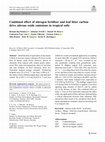
Nutrient Cycling in Agroecosystems, 2020
Intensification of agriculture in the tropics is likely to increase reactive nitrogen (N) losses ... more Intensification of agriculture in the tropics is likely to increase reactive nitrogen (N) losses in the form of nitrous oxide (N 2 O), however, drivers of emissions from tropical soils remain poorly understood. This study investigated the effect of leaf litter and urea fertiliser on N 2 O emissions from two Australian tropical mango orchards. Treatments included urea (25 g N m-2), leaf litter (1500 g m-2 dry matter), their combined application, and untreated control. Up to 80.5 ± 8.4 mg N 2 ON m-2 were lost within two weeks of treatment application, accounting for more than 60% of annual N 2 O emissions. Indirect emissions [ 30 mg m-2 d-1 were recorded at one site, potentially resulting from groundwater transported N. Highest annual N 2 O emissions were observed from Litter ? Urea with 130.4 mg N 2 ON m-2 y-1 , exceeding those from Urea-Only by a factor of two and those from Litter-Only by a factor of four. This resulted in residue and fertiliser emission factors (EF) of \ 0.01-0.37%, well below the IPCC and Tier 2 defaults, with whole orchard losses equivalent to 0.19-0.66 kg N 2 ON ha-1. The findings suggest N 2 O is N limited when no N fertiliser is applied, even when applying large amounts of litter-N, and by carbon (C) in the absence of litter. The combined effect of Litter ? Urea on N 2 O emissions surpassed the effect of the sole application of litter and urea, demonstrating a critical interaction between both substrates. This interaction effect needs to be considered when developing management strategies aimed at increasing soil C in tropical soils.
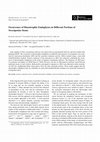
Stem samples of three sweetpotato cultivars were taken from an experimental field two and four mo... more Stem samples of three sweetpotato cultivars were taken from an experimental field two and four months after planting (MAP). The occurrence of diazotrophic endophytes in different stem portions of sweetpotato was examined by stem-pieces-incubation (SPI) and the acetylene reduction activity (ARA) method using a semi-solid modified Rennie medium. Positive responses of the stem-pieces to ARA were detected, confirming the occurrence of diazotropohic endophytes in the stems of Japanese sweetpotato cultivars. The frequency of ARA-positive portions was higher at 4 MAP than at 2 MAP. However, the site of ARA-positive portions varied between replicated stems in each cultivar. Both positive and negative responses to ARA were detected in tubes inoculat-ed with five neighboring thinly sliced pieces from the same internode portion. These results suggest that the diazotrophic endophytes that are culturable on semi-solid modified Rennie medium were discretely localized in sweetpotato stems.
Eepsea Research Report, Mar 1, 2013
Published by WorldFish (ICLARM) -Economy and Environment Program for Southeast Asia (EEPSEA) EEPS... more Published by WorldFish (ICLARM) -Economy and Environment Program for Southeast Asia (EEPSEA) EEPSEA Philippines Office, WorldFish Philippines Country Office, SEARCA bldg., College,

Studies were conducted to determine the population of N2-fixing endophytes in the sugarcane stem,... more Studies were conducted to determine the population of N2-fixing endophytes in the sugarcane stem, analyze the carbon compounds (organic acid and sugar) in the stem apoplast solution, and estimate the contribution of N2-fixation to the nitrogen uptake of sugarcane (%Ndfa). The data gathered showed that the number of endophytic bacteria in the stem of sugarcane cultivars ranged from 104 to 109 cells / mL juice and varied among sites and cultivars. Moreover, not all of the stem apoplast solutions of sugarcane species and clones were colonized by N2-fixing endophytes. Among the acetylene reduction activity (ARA)+ samples, the number of N2-fixing endophytes was high in Saccharum robustum clone Robustum 16, S. sinense clone Kouchi, and S. hybrid cv. NCo310. The %Ndfa in sugarcane cv. NiF-8 ranged from 14.1 to 26.0% based on 15N dilution technique and 26.15 to 37.5% using the 615N abundance method. The identified organic acid compounds in stem apoplast solutions were aconitate, malate, and...




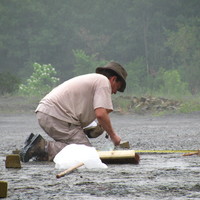






Uploads
Papers by Constancio Asis